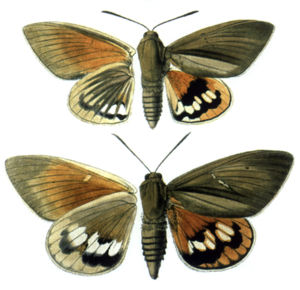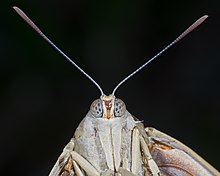Paysandisia archon
| Paysandisia archon | ||||||||||
|---|---|---|---|---|---|---|---|---|---|---|

Paysandisia archon , male above, female below, lower sides on the left, upper sides on the right |
||||||||||
| Systematics | ||||||||||
|
||||||||||
| Scientific name | ||||||||||
| Paysandisia archon | ||||||||||
| ( Burmeister , 1880) |
Paysandisia archon is a butterfly ( moth ) from the family of castniidae , which is common in South America and the end of the 20th century in Europe was introduced.
features
The wingspan of the moth is 80 to 110 millimeters. The antennae end in a gradually thickening antenna bulb and are similar to those of some butterflies. The head, thorax and abdomen are light brown. The forewings are also light brown, darker at the apex and outer edge and lighter at the inner edge. Above this there are one or two blackish longitudinal lines along the veins. In the females in particular, there are often a number of bright spots in the area of the discoid loader. The base and front edge of the hind wings are red, the fringing area is orange and has a brown border. The middle field is black and marked with six to seven light yellow to bluish-white elongated-oval spots in a very irregular row, which are located between the veins. The fringes of both wings are whitish.
distribution
Paysandisia archon occurs in Brazil, Uruguay, Paraguay and in northwestern Argentina. The species was introduced to Europe between around 1985 and 1995 and is currently spreading along the coasts of the Mediterranean and even in southern England. So far it is known from Spain (Provinces Alicante, Valencia, Castellón, Girona and Balearic Islands), France (Départements Pyrénées-Orientales, Aude, Hérault, Gard, Bouches-du-Rhône, Var, Alpes-Maritimes and since 2006 also in the region Midi-Pyrénées), Italy (Campania, Marche, Sicily and Lake Garda) and Great Britain (Sussex). The introduction to Spain and France possibly took place several times with palms of the genera Trithrinax and Butia imported from Argentina .
habitat
The species colonizes habitats in which its host plants occur. In Europe these are mainly planted ornamental palms in parks and gardens as well as the palm tree avenues in cities and towns.
Way of life and harmfulness
The moths are diurnal. The females lay the eggs, which are reminiscent of small grains of rice, on the soft base of palm trees. The almost unmarked, whitish caterpillars bore into the plant; the infestation can be recognized externally by drilling dust that emerges from the base of the leaf stalks or the stem. Adult caterpillars reach a length of 80 to 100 millimeters. They pupate in a cocoon made of palm fibers within the feeding tunnel created by the caterpillar.
While the species does not cause any major damage in its native South America, in Europe it has become a feared pest on the native and exotic palm species that are mostly planted here. The infested palm trees can dry up, die off completely and then topple over, which is particularly undesirable in the tourist areas. That is why the species in Europe is being tried in every possible way to combat and eradicate. Since no biological control methods are currently available, there is usually massive use of insecticides.
Food of the caterpillars
The caterpillars on Butia yatay , Chamaerops spec., Latania spec., Livistona chinensis , Phoenix canariensis , Syagrus romanzoffiana and Trithrinax campestris live in their natural range . In Europe it has so far been found on Chamaerops humilis , Livistona chinensis , Livistona decipiens and Livistona saribus , Phoenix species, including Phoenix canariensis , Phoenix dactylifera and Phoenix reclinata , Sabal spec., Trachycarpus fortunei , Trithrinax campestris and Washingtonia filifera .
Flight and caterpillar times
The moths have been observed in Europe from July to November.
Taxonomy
The monobasic genus Paysandisia , described for Castnia josepha (a younger subjective synonym of Castnia archon ), contains only one type of archon . Since the entire Castniini tribe needs a phylogenetic revision, it is to be expected that the species archon will change its genus with future taxonomic research results.
swell
literature
- Patrice Leraut: Moths of Europe, Vol. 1 (“Papillons de nuit”, 2006). NAP Éditions, Verrières le Buisson 2006, ISBN 2-913-68807-1 , 396 pp., 78 plates.
- Victor Sarto i Monteys: The discovery, description and taxonomy of "Paysandisia archon" (Burmeister, 1880). A castniid species recently found in southwestern Europe (Castniidae). In: Nota lepidopterologica , Vol. 25 (2002), pp. 3-15, ISSN 0342-7536 .
Web links
- Control methods - pictures of butterflies and caterpillars, damage and occurrence in France (French)
- Palms Journal - Pictures of moth, caterpillar and harmful image (English)
- Insectarium virtual - pictures of butterfly, caterpillar and harmful image (Spanish)
- Control of palm pests - pictures of moths, caterpillars and pests, infestation features (French)
- Paysandisia archon at Fauna Europaea. Retrieved February 25, 2011



